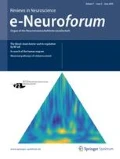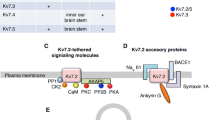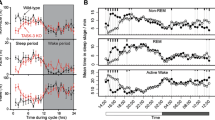Abstract
Discovered during the 1990s and in the beginning regarded as passive membrane pores, the family of two-pore domain potassium (K2P)-channels initially received only little attention. Today the view on this channel family comprising 15 ubiquitously expressed members in mammals has greatly changed. K2P-channels carry potassium outward current that counterbalances membrane depolarization and stabilizes the resting membrane potential. Thereby they are important regulators for the excitability and the firing behaviour especially in neurons. The long list of modulating mechanisms underlines the channels’ relevance. K2P-channels in the thalamus contribute to the regulation of the sleep-wake cycle. They also mediate the effect of volatile anaesthetics by supporting the thalamic activity mode that is also typical for sleep. This review summarizes our knowledge about K2P-channel physiology in the brain, provides an idea of the role of these channels in neurological diseases and lists open questions as well as technical challenges in K2P-channel research.



Similar content being viewed by others
References
Goldstein S, Bockenhauer D, O’Kelly I, Zilberberg N (2001) Potassium leak channels and the KCNK family of two-P-domain subunits. Nature reviews. Neuroscience 2:175–184
Lesage F, Guillemare E, Fink M, Duprat F, Lazdunski M, Romey G, Barhanin J (1996) TWIK-1, a ubiquitous human weakly inward rectifying K + channel with a novel structure. EMBO J 15:1004–1011
Lesage F, Lazdunski M (2000) Molecular and functional properties of two-pore-domain potassium channels. Am J Physiol Ren Physiol 279:801
Enyedi P, Czirják G (2010) Molecular background of leak K + currents: two-pore domain potassium channels. Physiol Rev 90:559–605
Mathie A (2007) Neuronal two-pore-domain potassium channels and their regulation by G protein-coupled receptors. J Physiol 578:377–385
Lesage F (2003) Pharmacology of neuronal background potassium channels. Neuropharmacology 44:1–7
Lesage F, Terrenoire C, Romey G, Lazdunski M (2000) Human TREK2, a 2P domain mechano-sensitive K + channel with multiple regulations by polyunsaturated fatty acids, lysophospholipids, and Gs, Gi, and Gq protein-coupled receptors. J Biol Chem 275:28398–28405
Maingret F, Lauritzen I, Patel A, Heurteaux C, Reyes R, Lesage F, Lazdunski M, Honoré E (2000) TREK-1 is a heat-activated background K(+) channel. EMBO J 19:2483–2491
Bayliss DA, Barrett PQ (2008) Emerging roles for two-pore-domain potassium channels and their potential therapeutic impact. Trends Pharmacol Sci 29:566–575
Talley E, Solorzano G, Lei Q, Kim D, Bayliss D (2001) CNS distribution of members of the two-pore-domain (KCNK) potassium channel family. J Neurosci Off J Soc Neurosci 21:7491–7505
Bista P, Cerina M, Ehling P, Leist M, Pape HC, Meuth SG, Budde T (2014) The role of two-pore-domain background K (K) channels in the thalamus. Pflugers Arch 467:895–905
Sherman S, Guillery R (2006) Exploring the thalamus and its role in cortical function, 2nd edn. The MIT Press, Cambridge
Llinás R, Steriade M (2006) Bursting of thalamic neurons and states of vigilance. J Neurophysiol 95:3297–3308
Pape HC (2005) Der Thalamus: Das Tor zum Bewußtsein. Neuroforum 2/05:44–54
Llinás R, Ribary U, Jeanmonod D, Kronberg E, Mitra P (1999) Thalamocortical dysrhythmia: a neurological and neuropsychiatric syndrome characterized by magnetoencephalography. Proc Nat Acad Sci USA 96:15222–15227
Llinás R, Urbano F, Leznik E, Ramírez R, van Marle H (2005) Rhythmic and dysrhythmic thalamocortical dynamics: GABA systems and the edge effect. Trends Neurosci 28:325–333
Budde T, Mager R, Pape H-C (1992) Different types of potassium outward current in relay neurons acutely isolated from the rat lateral geniculate nucleus. Eur J Neurosci 4:708–722
Meuth S, Budde T, Kanyshkova T, Broicher T, Munsch T, Pape H-C (2003) Contribution of TWIK-related acid-sensitive K + channel 1 (TASK1) and TASK3 channels to the control of activity modes in thalamocortical neurons. J Neurosci 23:6460–6469
Meuth S, Aller M, Munsch T, Schuhmacher T, Seidenbecher T, Meuth P, Kleinschnitz C, Pape H-C, Wiendl H, Wisden W, Budde T (2006) The contribution of TWIK-related acid-sensitive K + -containing channels to the function of dorsal lateral geniculate thalamocortical relay neurons. Mol Pharmacol 69:1468–1476
Meuth S, Kanyshkova T, Meuth P, Landgraf P, Munsch T, Ludwig A, Hofmann F, Pape H-C, Budde T (2006) Membrane resting potential of thalamocortical relay neurons is shaped by the interaction among TASK3 and HCN2 channels. J Neurophysiol 96:1517–1529
Bista P, Pawlowski M, Cerina M, Ehling P, Leist M, Meuth P, Aissaoui A, Borsotto M, Heurteaux C, Decher N, Pape HC, Oliver D, Meuth SG, Budde T (2015) Differential phospholipase C-dependent modulation of TASK and TREK two-pore domain K + channels in rat thalamocortical relay neurons. J Physiol 593(1):127–144
Budde T, Coulon P, Pawlowski M, Meuth P, Kanyshkova T, Japes A, Meuth S, Pape H-C (2008) Reciprocal modulation of I (h) and I (TASK) in thalamocortical relay neurons by halothane. Pflügers Archiv 456:1061–1073
Musset B, Meuth S, Liu G, Derst C, Wegner S, Pape H-C, Budde T, Preisig-Müller R, Daut J (2006) Effects of divalent cations and spermine on the K + channel TASK-3 and on the outward current in thalamic neurons. J Physiol 572:639–657
Lindner M, Leitner M, Halaszovich C, Hammond G, Oliver D (2011) Probing the regulation of TASK potassium channels by PI4, 5P2 with switchable phosphoinositide phosphatases. J Physiol 589:3149–3162
Bittner S, Budde T, Wiendl H, Meuth S (2010) From the background to the spotlight: TASK channels in pathological conditions. Brain Pathol (Zurich, Switzerland) 20:999–1009
Siemkowicz E, Hansen A (1981) Brain extracellular ion composition and EEG activity following 10 min ischemia in normo- and hyperglycemic rats. Stroke; J Cereb Circ 12:236–240
Steinke W, Sacco RL, Mohr JP, Foulkes MA, Tatemichi TK, Wolf PA, Price TR, Hier DB (1992) Thalamic stroke. Presentation and prognosis of infarcts and hemorrhages. Arch Neurol 49:703–710
Ehling P, Göb E, Bittner S, Budde T, Ludwig A, Kleinschnitz C, Meuth S (2013) Ischemia-induced cell depolarization: does the hyperpolarization-activated cation channel HCN2 affect the outcome after stroke in mice? Exp Transl Stroke Med 5:16
Meuth S, Kleinschnitz C, Broicher T, Austinat M, Braeuninger S, Bittner S, Fischer S, Bayliss D, Budde T, Stoll G, Wiendl H (2009) The neuroprotective impact of the leak potassium channel TASK1 on stroke development in mice. Neurobiol Dis 33:1–11
Ehling P, Bittner S, Bobak N, Schwarz T, Wiendl H, Budde T, Kleinschnitz C, Meuth S (2010) Two pore domain potassium channels in cerebral ischemia: a focus on K2P9.1 (TASK3, KCNK9). Exp Transl Stroke Med 2:14
Bittner S, Meuth S, Göbel K, Melzer N, Herrmann A, Simon O, Weishaupt A, Budde T, Bayliss D, Bendszus M, Wiendl H (2009) TASK1 modulates inflammation and neurodegeneration in autoimmune inflammation of the central nervous system. Brain 132:2501–2516
Deng PY, Lei S (2008) Serotonin increases GABA release in rat entorhinal cortex by inhibiting interneuron TASK-3 K + channels. Mol Cell Neurosci 39:273–284
Dey D, Eckle VS, Vitko I, Sullivan KA, Lasiecka ZM, Winckler B, Stornetta RL, Williamson JM, Kapur J, Perez-Reyes E (2014) A potassium leak channel silences hyperactive neurons and ameliorates status epilepticus. Epilepsia 55:203–213
Chatelain F, Bichet D, Douguet D, Feliciangeli S, Bendahhou S, Reichold M, Warth R, Barhanin J, Lesage F (2012) TWIK1, a unique background channel with variable ion selectivity. Proc Nat Acad Sci USA 109:5499–5504
Ma L, Zhang X, Zhou M, Chen H (2012) Acid-sensitive TWIK and TASK two-pore domain potassium channels change ion selectivity and become permeable to sodium in extracellular acidification. J Biol Chem 287:37145–37153
Patel AJ, Honore E, Lesage F, Fink M, Romey G, Lazdunski M (1999) Inhalational anesthetics activate two-pore-domain background K + channels. Nat Neurosci 2:422–426
Rajan S, Wischmeyer E, Karschin C, Preisig-Müller R, Grzeschik K, Daut J, Karschin A, Derst C (2001) THIK-1 and THIK-2, a novel subfamily of tandem pore domain K + channels. J Biol Chem 276:7302–7311
Steinberg EA, Wafford KA, Brickley SG, Franks NP, Wisden W (2014) The role of K channels in anaesthesia and sleep. Pflugers Arch 467:907–916
Ries CR, Puil E (1999) Mechanism of anesthesia revealed by shunting actions of isoflurane on thalamocortical neurons. J Neurophysiol 81:1795–1801
Bichet D, Blin S, Feliciangeli S, Chatelain FC, Bobak N, Lesage F (2014) Silent but not dumb: how cellular trafficking and pore gating modulate expression of TWIK1 and THIK2. Pflugers Arch 467:1121–1131
Seifert G, Hüttmann K, Binder D, Hartmann C, Wyczynski A, Neusch C, Steinhäuser C (2009) Analysis of astroglial K + channel expression in the developing hippocampus reveals a predominant role of the Kir4.1 subunit. J Neurosci 29:7474–7488
Woo DH, Han KS, Shim JW, Yoon BE, Kim E, Bae JY, Oh SJ, Hwang EM, Marmorstein AD, Bae YC, Park JY, Lee CJ (2012) TREK-1 and Best1 channels mediate fast and slow glutamate release in astrocytes upon GPCR activation. Cell 151:25–40
Kim JE, Yeo SI, Ryu HJ, Chung CK, Kim MJ, Kang TC (2011) Changes in TWIK-related acid sensitive K + -1 and – 3 channel expressions from neurons to glia in the hippocampus of temporal lobe epilepsy patients and experimental animal model. Neurochem Res 36:2155–2168
Hawkins V, Butt A (2013) TASK-1 channels in oligodendrocytes: a role in ischemia mediated disruption. Neurobiol Dis 55:87–94
Borsotto M, Veyssiere J, Moha Ou Maati H, Devader C, Mazella J, Heurteaux C (2015): Targeting two-pore domain K(+) channels TREK-1 and TASK-3 for the treatment of depression: a new therapeutic concept. Br J Pharmacol 172:771–784
Heurteaux C, Lucas G, Guy N, El Yacoubi M, Thummler S, Peng XD, Noble F, Blondeau N, Widmann C, Borsotto M, Gobbi G, Vaugeois JM, Debonnel G, Lazdunski M (2006) Deletion of the background potassium channel TREK-1 results in a depression-resistant phenotype. Nat Neurosci 9:1134–1141
Mazella J, Petrault O, Lucas G, Deval E, Beraud-Dufour S, Gandin C, El-Yacoubi M, Widmann C, Guyon A, Chevet E, Taouji S, Conductier G, Corinus A, Coppola T, Gobbi G, Nahon JL, Heurteaux C, Borsotto M (2010) Spadin, a sortilin-derived peptide, targeting rodent TREK-1 channels: a new concept in the antidepressant drug design. PLoS Biol 8:e1000355
Aryal P, Abd-Wahab F, Bucci G, Sansom MS, Tucker SJ (2014) A hydrophobic barrier deep within the inner pore of the TWIK-1 K2P potassium channel. Nat Commun 5:4377
Miller AN, Long SB (2012) Crystal structure of the human two-pore domain potassium channel K2P1. Science 335:432–436
Brohawn SG, del Marmol J, MacKinnon R (2012) Crystal structure of the human K2P TRAAK, a lipid- and mechano-sensitive K + ion channel. Science 335:436–441
Blin S, Chatelain FC, Feliciangeli S, Kang D, Lesage F, Bichet D (2014) Tandem pore domain halothane-inhibited K + channel subunits THIK1 and THIK2 assemble and form active channels. J Biol Chem 289:28202–28212
Czirjak G, Enyedi P (2002) Formation of functional heterodimers between the TASK-1 and TASK-3 two-pore domain potassium channel subunits. J Biol Chem 277:5426–5432
Plant LD, Zuniga L, Araki D, Marks JD, Goldstein SA (2012) SUMOylation silences heterodimeric TASK potassium channels containing K2P1 subunits in cerebellar granule neurons. Sci Signal 5:ra84
Hwang EM, Kim E, Yarishkin O, Woo DH, Han KS, Park N, Bae Y, Woo J, Kim D, Park M, Lee CJ, Park JY (2014) A disulphide-linked heterodimer of TWIK-1 and TREK-1 mediates passive conductance in astrocytes. Nat Commun 5:3227
Blondeau N, Petrault O, Manta S, Giordanengo V, Gounon P, Bordet R, Lazdunski M, Heurteaux C (2007) Polyunsaturated fatty acids are cerebral vasodilators via the TREK-1 potassium channel. Circ Res 101:176–184
Lauritzen I, Blondeau N, Heurteaux C, Widmann C, Romey G, Lazdunski M (2000) Polyunsaturated fatty acids are potent neuroprotectors. EMBO J 19:1784–1793
Bittner S, Ruck T, Schuhmann M, Herrmann A, Maati H, Bobak N, Göbel K, Langhauser F, Stegner D, Ehling P, Borsotto M, Pape H-C, Nieswandt B, Kleinschnitz C, Heurteaux C, Galla H-J, Budde T, Wiendl H, Meuth S (2013) Endothelial TWIK-related potassium channel-1 (TREK1) regulates immune-cell trafficking into the CNS. Nat Med 19:1161–1165
Ma L, Zhang X, Chen H (2011) TWIK-1 two-pore domain potassium channels change ion selectivity and conduct inward leak sodium currents in hypokalemia. Sci Signal 4:ra37
Acknowledgement
We gratefully thank Heike Blum for excellent graphical illustration.
Author information
Authors and Affiliations
Corresponding author
Additional information
Note that a special issue on K2P-channels was published in Pflügers Archiv—European Journal of Physiology in May 2015. This issue is considerably based on contributions from members of the DFG research group “K2P-channels—from molecules to physiology and pathophysiology” (FOR1086).
Rights and permissions
About this article
Cite this article
Ehling, P., Bittner, S., Meuth, S. et al. TASK, TREK & Co.: a mutable potassium channel family for diverse tasks in the brain. e-Neuroforum 6, 29–37 (2015). https://doi.org/10.1007/s13295-015-0007-x
Published:
Issue Date:
DOI: https://doi.org/10.1007/s13295-015-0007-x




